Vets, a local farmer, and animal rescue teams were among those involved in a bull-related rescue operation in recent days.
According to a spokesperson for Bromyard Fire Station, a bull had become “submerged” in a pool, which was “drying out due to no rain”.
“Part of the wet/damp area had some very nice looking green grass that the bull wanted to take advantage of. He soon found himself stuck in the mud, 3/4 the way up his body.”
Animal rescue teams from Bromyard & Pershore, along with a fire crew from Bromsgrove and Malverns off-road vehicles, were deployed for the large animal rescue.
Richard and Sophie Aylett and Sophie Bonnevie from Meadows Farm Vets Ltd at Bromsgrove oversaw the bull’s welfare during the rescue and gave advice to crews.
“Crews worked hard to place strops around his body when in place Sophie Bonnevie injected him to sedate him.”
“8 minutes later, he was ready to be removed from the area. Peter, a local farmer, had brought along his telehandler.”
“The bull was approximately 900kgs in weight, so a large animal to move,” the spokesperson said.
“The bull was pulled from the mud onto a large glide board so he could be slid across the ground to a secure pen that had been supplied by the Meadow Farm Vets.”
“This was erected in the field and was used as a place of safety until the sedation had time to wear off. He is expected to make a full recovery,” the spokesperson concluded.
Scanning cows
According to Teagasc’s David Argue, pregnancy scanning can provide invaluable information in relation to individual cow fertility and your herd’s overall fertility status.
He advises that the “ideal” time to scan your cow is between 5-14 weeks of pregnancy.
Moreover, he urges farmers to scan four weeks into the breeding season to identify bull or cow fertility problems and to perform a main scan five weeks after removing the bull.
Read more on this news article.





